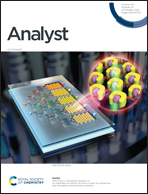Nanostructured mesoporous gold electrodes detect protein phosphorylation in cancer with electrochemical signal amplification†
Abstract
Protein phosphorylation is a post-translational modification of kinase proteins that changes a protein's conformation to regulate crucial biological functions. However, the phosphorylation of protein is significantly altered during cancer progression which triggers abnormal cellular pathways and this phosphorylation can serve as an emergent diagnostic and prognostic biomarker for cancer. Herein, we develop a nanostructured mesoporous gold electrode (NMGE)-based biosensor that enables a highly sensitive detection of protein phosphorylation with electrochemical signal amplification. The biosensor comprises nanostructured mesoporous gold electrodes whose electro-conductive framework is superior to that of the nonporous electrodes. We characterize our developed nano/mesoporous gold electrode with various electrochemical methods in the presence of the [Fe(CN)6]3−/4− redox system. We find that the mesoporous gold electrode catalyzes both the oxidation and reduction processes of the [Fe(CN)6]3−/4− system and generates a current signal that is 3 times higher than that of the nonporous gold electrode. This superior signal transduction of our nano/mesoporous gold electrode is enabled through a pore-induced (i) high electrochemically active surface area and (ii) reduced impedance with a high signal to noise ratio. The assay utilizes direct adsorption of an immunoprecipitated purified BRAF protein towards the mesoporous gold electrode and thus avoids the cumbersome sensor surface functionalization. Our developed biosensor detects the phosphorylated BRAF protein with a 2.5-fold increase in sensitivity and an ≈10-fold increase in the limit of detection (LOD) in comparison with the nonporous gold electrodes. The assay also works on a wide dynamic range from 0.5 to 20 ng μL−1 of the protein which further shows its potential for clinical application. We envisage that this nanostructured mesoporous gold biosensor will be of high interest for clinical application.



 Please wait while we load your content...
Please wait while we load your content...